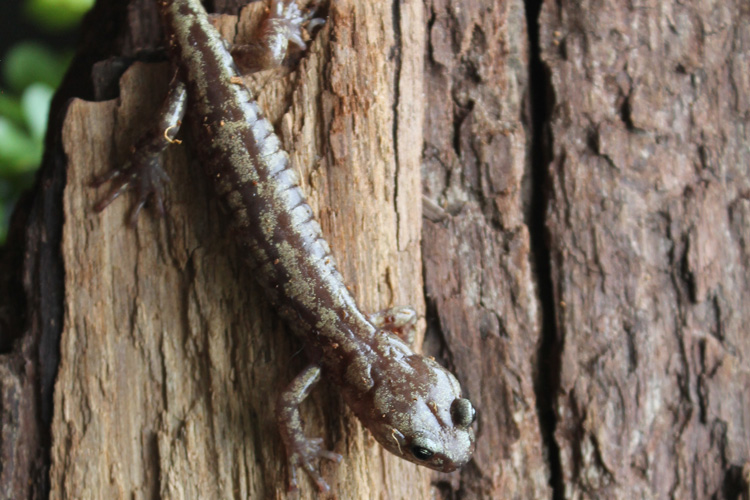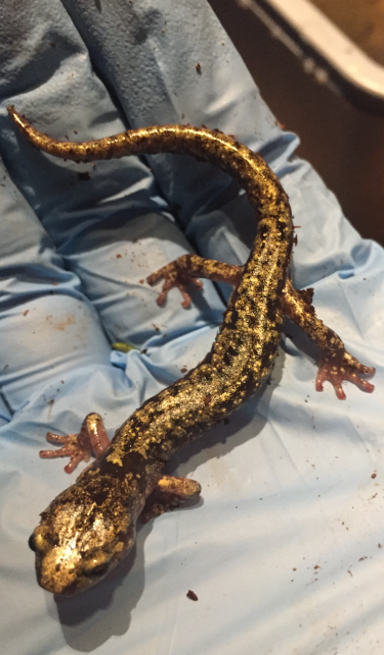Skydiving salamanders live in world’s tallest trees
Salamanders living in the crowns of redwoods are able to glide and maneuver in freefall, suggesting adaptation to living at heights

May 23, 2022
Salamanders that live their entire lives in the crowns of the world’s tallest trees, California’s coast redwoods, have evolved a behavior well-adapted to the dangers of falling from high places: the ability to parachute, glide and maneuver in mid-air.
Flying squirrels, not to mention numerous species of gliding frogs, geckos, and ants and other insects, are known to use similar aerial maneuvers when jumping from tree to tree or when falling, so as to remain in the trees and avoid landing on the ground.
Similarly, the researchers suspect that this salamander’s skydiving skills are a way to steer back to a tree it’s fallen or jumped from, the better to avoid terrestrial predators.
“While they’re parachuting, they have an exquisite amount of maneuverable control,” said Christian Brown, a doctoral candidate at the University of South Florida (USF) in Tampa and first author of a paper about these behaviors. “They are able to turn. They are able to flip themselves over if they go upside down. They’re able to maintain that skydiving posture and kind of pump their tail up and down to make horizontal maneuvers. The level of control is just impressive.”
The aerial dexterity of the so-called wandering salamander (Aneides vagrans) was revealed by high-speed video footage taken in a wind tunnel at the University of California, Berkeley, where the salamanders were nudged off a perch into an upward moving column of air simulating free fall.
“What struck me when I first saw the videos is that they (the salamanders) are so smooth — there’s no discontinuity or noise in their motions, they’re just totally surfing in the air,” said Robert Dudley, UC Berkeley professor of integrative biology and an expert on animal flight. “That, to me, implies that this behavior is something deeply embedded in their motor response, that it (falling) must happen at reasonably high frequencies so as to effect selection on this behavior. And it’s not just passive parachuting, they’re not just skydiving downwards. They’re also clearly doing the lateral motion, as well, which is what we would call gliding.”

The wandering salamander, Aneides vagrans, is about 4 inches (10 centimeters) long and lives its entire life in the crowns of redwood trees more than 150 feet above the ground. Researchers discovered that it has adapted to its high-rise lifestyle by developing the ability to parachute and glide when falling. (Photo credit: Christian Brown)
The behavior is all the more surprising because the salamanders, aside from having slightly larger foot pads, look no different from other salamanders that aren’t aerially maneuverable. They have no skin flaps, for example, that would tip you off to their parachuting ability.
“Wandering salamanders have big feet, they have long legs, they have active tails. All of these things lend themselves to aerial behaviors. But everybody just assumed that was for climbing, because that’s what they use those features for when we’re looking at them,” Brown said. “So, it’s not really a dedicated aerodynamic control surface, but it functions as both. It helps them climb, and it seems to help them parachute and glide, as well.”
Among the questions the researchers hope to answer in future research are how salamanders manage to parachute and maneuver without obvious anatomical adaptations to gliding and whether many other animals with similar aerial skills have never been noticed before.
“Salamanders are sluggish, you don’t think of them as having particularly fast reflexes. It’s life in the slow lane. And flight control is all about rapid response to dynamic visual cues and being able to target and orient and change your body position,” Dudley said. “So, it’s just kind of odd. How often can this be happening, anyway, and how would we know?”
A paper describing the behavior was published today (May 23) in the journal Current Biology.
Life in the canopy
Using the wind tunnel, Brown and UC Berkeley graduate student Erik Sathe compared the gliding and parachuting behavior of A. vagrans — adults are about 4 inches (10 centimeters) from snout to tip of tail — with the abilities of three other salamander species native to Northern California, each with varying degrees of arboreality — that is, the propensity to climb or live in trees. The wandering salamander, which probably spends its entire life in a single tree, moving up and down but never touching the ground, was the most proficient skydiver. A related species, the so-called arboreal salamander, A. lugubris, which lives in shorter trees, such as oaks, was nearly as effective at parachuting and gliding.
Two of the least arboreal salamanders — Ensatina eschscholtzii, a forest floor-dwelling salamander, and A. flavipunctatus, the speckled black salamander, which occasionally climbs trees — essentially flailed ineffectively for the few seconds they were airborne in the wind tunnel. All four species are plethodontid, or lungless, salamanders, the largest family of salamanders and mostly found in the Western Hemisphere.
“The two least arboreal species flail around a lot. We call it ineffective, undulating motion because they don’t glide, they don’t move horizontally, they just kind of hover in the wind tunnel freaking out,” Brown said. “The two most arboreal species never actually flailed.”
Brown encountered these salamanders while working in California’s Humboldt and Del Norte counties with nonprofit and university conservation groups that mark and track the animals that live in the redwood canopy, primarily in old growth forest some 150 feet off the ground. Using ropes and ascenders, the biologists regularly climb the redwoods — the tallest of which rise to a height of 380 feet — to capture and mark wandering salamanders. Over the past 20 years, as part of a project led by James Campbell-Spickler, now director of the Sequoia Park Zoo in Eureka, the researchers discovered that most of their marked salamanders could be found in the same tree year after year, although at different heights. They live primarily in fern mats growing in the duff, the decaying vegetable matter that collects in the junctions of large branches. Brown said that few marked wandering salamanders from the redwood canopy have been found on the ground, and most of those were found dead.

A wandering salamander found in Humboldt Co., California. (Photo credit: Christian Brown)
Brown noticed, when picking them up to mark them, that the salamanders were quick to leap out of his hands. Even a light tap on a branch or a shadow passing nearby were enough to get them to jump from the redwood canopy. Given their location high above the forest floor, their nonchalant leaps into thin air were surprising.
“They jump, and before they’ve even finished toeing off, they’ve got their forelimbs splayed out, and they’re ready to go,” he said. “So, the jump and the parachute are very closely tied together. They assume the position immediately.”
When he approached Dudley, who has studied such behavior in other animals, he invited Brown to bring some of the salamanders into his wind tunnel to record their behavior. Using a high-speed video camera shooting at 400 frames per second, Brown and Sathe filmed the salamanders for as long as they floated on the column of air, sometimes up to 10 seconds.
They then analyzed the frames to determine the animals’ midair posture and to deduce how they used their legs, bodies and tails to maneuver. They typically fell at a steep angle, only 5 degrees from vertical, but based on the distances between branches in the crowns of redwoods, this would usually be sufficient for them to reach a branch or trunk before they hit the ground. Parachuting reduced their free-fall speed by about 10%.
Brown suspects that their aerial skills evolved to deal with falls, but have become part of their behavioral repertoire and perhaps their default method of descent. He and USF undergraduate Jessalyn Aretz found, for example, that walking downward was much harder for the salamander than walking on a horizontal branch or up a trunk.
“That suggests that when they’re wandering, they’re likely walking on flat surfaces, or they’re walking upward. And when they run out of habitat, as the upper canopy becomes drier and drier, and there’s nothing else for them up there, they could just drop back down to those better habitats,” he said. “Why walk back down? You’re already probably exhausted. You’ve burned all your energy, you’re a little 5 gram salamander, and you’ve just climbed the tallest tree on Earth. You’re not going to turn around and walk down — you’re going to take the gravity elevator.”

Christian Brown took a selfie while climbing an old-growth coast redwood tree in Orick, California.
Brown sees A. vagrans as another poster child for old growth forests that is akin to the spotted owl because it is found primarily in the crowns of the tallest and oldest redwoods, although also in Douglas fir and Sitka spruce.
“This salamander is a poster child for the part of the redwoods that was almost completely lost to logging — the canopy world. It is not there in these new-growth forests created by logging companies,” he said. “Perhaps it would help not just efforts in conserving redwoods, but restoring redwoods, so that we could actually get canopy ecosystems. Restoring redwoods to the point of fern mats, to the point of salamanders in the canopy — that would be a new bar for conservation.”
In the meantime, this denizen of old growth forests has a lot to tell us about evolution and perhaps the origin of flight, said Dudley.
“It (gliding) is a novelty, something unexpected in an otherwise well-studied group of animals, but it illustrates the urgency with which animals that are living in trees must evolve aerial capacity, even if they don’t have wings,” Dudley said. “Flight, in the sense of controlled aerial behavior, is very common. They’re controlling their body posture, and they’re moving laterally. This predisposes many, many things that are living in trees to ultimately evolve flapping flight, which is probably hard to evolve and why it has only turned up three times on the planet today.”
Co-authors of the paper with Brown and Dudley are Sathe and Stephen Deban, professor of integrative biology at the University of South Florida.